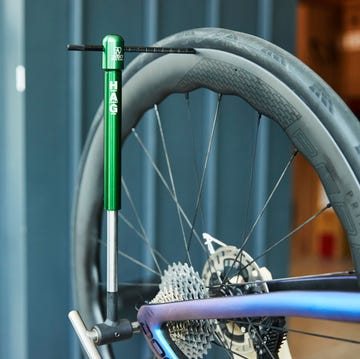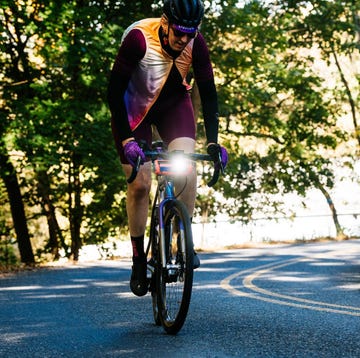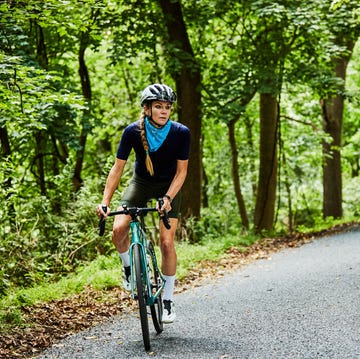If you’re like most cyclists, you probably don’t think a whole lot about what it takes to stay balanced. But if you’re lucky enough to continue (or begin) cycling in your 50s and beyond, age-related performance losses become inevitable. That means maintaining stability, both on and off the bike, becomes much more important.
At the most basic level, “balance is the ability to maintain forward motion on the bike,” says Jim Capra, head coach of Tyler Hamilton Training. And without excellent balance, you can forget about stability, which is essentially your ability to stay upright in the face of disturbances like a sudden wind gust, says Molly Schmelzle, C.S.C.S., and a CTS expert coach.
Check Out The Ride Strong at 50+ Program
And while you probably won’t wake up on your 50th birthday performing significantly worse than you did the day before, “Fifty is a line of demarcation where issues become more exaggerated,” says Capra. But there’s plenty you can do to maintain your balance—and your most ambitious cycling pursuits—as you age.
Why Cyclists Ages 50+ Need to Train for Balance
Before you get into what you can do to keep your balance skills strong, it’s important to understand how normal, healthy aging contributes to balance deficits for cyclists who are 50 and older.
Age-related muscle loss
No matter how fit you are, everyone experiences sarcopenia, or gradual age-related loss of muscle mass beginning at age 30. And, according to the Journal of Cachexia, Sarcopenia and Muscle, this loss of muscle mass and associated strength accelerates around age 50.
While research published in the Journal of Aging and Physical Activity shows that the loss of strength is related to balance deficits, losing strength in certain muscle groups, particularly your hips and glutes, can seriously impact older cyclists’ balance, says Capra. And while those limitations might not cause you to crash your bike right now, “poor or diminished balance skills at age 50 can translate 25 years later to a fall in the house and a hip fracture,” he says.
Age-related vision loss
Another major factor impacting balance is the natural vision loss that occurs as you age, says Capra. You might have no problem standing on one foot and maintaining your balance—but if you close your eyes and struggle to stay upright, it’s pretty easy to see how much your vision impacts your balance.
As you age, it becomes harder to alternate your focus between near and far distances. When you’re rolling at a high speed, the extra split-second it takes to glance from your Garmin to the road hazard 50 feet ahead can be the difference between staying upright and a nasty crash.
While age-related vision issues may be inevitable, the more you can do to bolster the systems you do have control over (i.e., neuromuscular agility, muscle strength, and balance), the safer you’ll be out on the roads and trails.
Cycling’s unique demands
Cycling is a highly repetitive, non-weight-bearing activity that forces your body into a static position for long periods of time, which means cyclists have to go out of their way to get the force inputs from the ground that challenge and develop their balance, says Schmelzle. Add the fact that many go from their bikes to their cars to desks, and you have a recipe for diminished balance, she says.
7 Ways Cyclists 50+ Can Develop and Maintain Optimum Balance
There’s no shortage of steps you can take to keep your balance sharp as you age. Here are some of our experts’ best strategies.
Strength Training
Why do it:
Building muscle is one of the best things you can do for your balance, says Schmelzle. A 2020 meta-analysis by Life journal found that engaging in resistance training significantly improved balance in adult and older adult populations. For cyclists ages 50 and up, that means it’s imperative to engage in strength training regularly. When it comes to muscle mass, due to the natural process of aging, “if we’re not training it, we’re losing it,” says Schmelzle.
How to do it:
Start by choosing weights that feel heavy but doable; the weight should allow you to perform six to 10 reps with about four reps in reserve. In other words, aim to complete your last rep feeling like you could only do about four more with good form, says Schmelzle. That said, you may need to begin with bodyweight, depending on your tolerance and strength training background.
A few moves to focus on to help develop both balance and strength include single leg deadlifts, Bulgarian split squats, and single leg glute bridges, all of which can be progressed from bodyweight to increasingly heavy weights, says Schmelzle.
Once you master these movements with bodyweight, make them more challenging by adding weight, spending more time under tension (i.e., holding at the bottom of the lift for a count of 2 or more) and/or doing them barefoot.
How often to do it:
Shoot for a 30-minute session two to three times a week at a minimum.
Agility Training
Why do it:
The more agile you are, the easier it is to maintain control of your bike on a technical trail, a steep descent, or in a crowded pack, says Schmelzle.
How to do it:
Roll out your or buy an agility ladder and have fun with drills like 2 in 2 out, where you’re jumping into the next square with both feet together and then jumping to the next square and landing with your feet apart (outside the ladder) two times. Once you get the hang of it, try going faster or build up to hopping on one leg. You can also try hopping laterally or make up your own drills.
If you don’t have a ladder or space is an issue, jumping rope is another simple way to develop your agility, says Schmelzle.
How often to do it:
Add a few minutes of agility work to your strength routine two to three times a week.
Go Barefoot
Why do it:
When you’re in the saddle, “your foot is locked almost into pronation the whole time,” says Schemelzle. In other words, your feet are maintaining a position that keeps them rolled inward. While this position isn’t inherently bad, staying in it for hours at a time, multiple times a week “makes you really rigid,” she says. Going barefoot helps you develop the foot stability and strength you need to ensure a solid foundation.
How to do it:
Schmelzle suggests going shoeless as often as you can tolerate, starting with walking around your house. Once you get used to that, experiment with doing strength and mobility work barefoot. If you work out at a facility that requires close-toed shoes, minimalist shoes or zero-drop shoes are good alternatives, she says.
How often to do it:
Go barefoot as often and for as long as you feel comfortable. However, if you’re used to wearing supportive shoes, ease into it gradually.
Ride in the Wind
Why do it:
Riding well in windy conditions not only builds confidence for gusty days, it also sharpens your balance and makes you a stronger, more confident cyclist. “When you learn to maintain a nice, quiet, relaxed upper body, the bike may pivot a little underneath you, but that’s all it’s going to do,” says Capra.
On the other hand, when you tense up in the wind, as most of us tend to, “your body becomes a sail and the bike blows around with you,” says Capra.
How to do it:
When the wind kicks up, rather than white knuckling your handlebars, keep a relaxed grip, says Capra. If getting out on a blustery day sounds too intimidating, start with breathwork on the bike under calm conditions. “Try cruising along at an easy pace and taking deep belly breaths to maintain a relaxed, loose, quiet upper body,” says Capra.
Get Out of the Saddle
Why do it:
The old adage, “Use it or lose it,” is certainly true when it comes to getting out of the saddle. “I’ve worked with a lot of older cyclists who feel like they can’t get out of the saddle,” says Schmelzle. The antidote? Get out of your saddle anyway—even if it’s a little outside your comfort zone.
Not only will standing over the saddle help you get over your fear of doing just that, it also challenges your balance and facilitates explosive power development, which are essential for older cyclists, says Schmelzle. This move is especially good for targeting the glutes, a muscle group that cyclists tend to underuse, as we often become quad dominant, she says.
How to do it:
The best place to start getting out of the saddle, particularly if you’re hesitant to try it, is indoors, on a spin bike or on a trainer (but not rollers). Once you’re confident hopping out of the saddle indoors, try it when you’re riding outdoors, first on even surfaces, and then on more challenging terrain as you get comfortable with it.
How often to do it:
Schmelzle suggests injecting a few bouts of standing into your workout as often as possible, ideally every time you ride your bike.
Super Slow Pedaling
Why do it:
“It seems counterintuitive, but pedaling as slowly as possible eliminates the momentum of the bike, so you are completely responsible for keeping the bike upright,” says Capra. It also helps to engage the cycling-specific muscles that directly affect balance, including the hips, which are crucial for cycling power but often take a backseat when the quads take over, he says.
How to do it:
Find a hill and pedal as slowly as you possibly can while continuing to ride in a straight line. You can certainly do this drill on flat terrain if dropping your cadence on a climb strains your knees, but know that you’ll have an easier time moving slowly on an incline.
No matter how you approach it, the goal is to avoid “paperboying,” or zigzagging, back and forth, says Capra. “We want you to develop the ability to go slower and slower while maintaining a straight line.”
How often to do it:
A little goes a long way. Injecting just one or two minutes of this drill into your routine one or two times a week is plenty, says Capra.
Single Leg Pedaling Drill
Why do it:
Pedaling with one leg at a time helps to engage the core muscles that contribute to good balance on the bike, says Capra.
How to do it:
This is a great drill to get comfortable with on your trainer or on a spin bike where you don’t have to worry about staying upright, says Capra. Once you’re confident doing it inside, try it outside on a flat, quiet road.
To do it, unclip one foot from your pedal and let your foot hang free. With your other foot, pedal at a relatively low cadence, about 70 RPM for 30 seconds, then switch legs and pedal with the opposite foot for 30 seconds at about 70 RPM. Next, pedal for a minute with both feet clipped in at 90 RPM or higher. Capra suggests doing this two-minute drill twice for a total of four minutes and gradually working up to completing two sets of five rounds, or two 10-minute sets.
How often to do it:
Aim to fit single-leg drills into your schedule one to three times per week.

Pam Moore is an occupational therapist-turned-intuitive eating coach, certified personal trainer, and award-winning freelance writer with bylines in outlets including The Washington Post, Time, SELF, Outside, Runner's World, and others. Listen to her podcast, Real Fit, or subscribe to her newsletter, Real Nourished, at













